FCH HVAC Honeycomb Ring Network—Transition from Traditional Power Supply Systems in Existing and Revitalized Areas
Abstract
:1. Introduction
2. Materials and Methods
2.1. FCH HVAC Technology
- A network with independent rings that power 8 buildings with 18 kW each;
- Distance between manholes and connections to buildings is approx. 20 m;
- Groundwater level 3–6 m below ground level;
- Depth of the levels approximately 5 m;
- Expected result at a temperature difference of 2 K.
2.2. FCH HVAC System in a Ring Configuration
3. Results and Discussion
- -
- Area served by FCH HVAC Centrals—33,000.00 m2;
- -
- Ventilation air supply rate indicator—8 m3/h/m2.
- Small well depths in the range of 20 m to 50 m, with competition of 100 m to 150 m.
- The use of steel exchangers when competing with PE.
- A ring system that receives or gives off energy over a length of about 5 m.
- One direction of flow and regeneration of the system.
- The possibility of expanding the system with additional rings.
4. Conclusions
Author Contributions
Funding
Data Availability Statement
Conflicts of Interest
References
- Kandelousi, M.S. HVAC System; BoD—Books on Demand: Norderstedt, Germany, 2018; ISBN 978-1-78984-432-0. [Google Scholar]
- Quan, S.J.; Chang, S.; Castro-Lacouture, D.; Igou, T.K.; Dutt, F.; Ding, J.; Chen, Y.; Pei-Ju Yang, P. Planning Decentralized Urban Renewable Energy Systems Using Algal Cultivation for Closed-Loop and Resilient Communities. Environ. Plan. B Urban Anal. City Sci. 2022, 49, 1464–1488. [Google Scholar] [CrossRef]
- Santillan, M.R.; Syn, J.W.; Charani Shandiz, S.; Huang, Y.; Pires de Lacerda, M.; Rismanchi, B. A Technology Assessment Approach for Achieving Sustainable Communities: An Energy Master Plan for a New Urban Development. Appl. Sci. 2022, 12, 3860. [Google Scholar] [CrossRef]
- Singh, T.; Solanki, A.; Sharma, S.K.; Nayyar, A.; Paul, A. A Decade Review on Smart Cities: Paradigms, Challenges and Opportunities. IEEE Access 2022, 10, 68319–68364. [Google Scholar] [CrossRef]
- Desvallées, L. Low-Carbon Retrofits in Social Housing: Energy Efficiency, Multidimensional Energy Poverty, and Domestic Comfort Strategies in Southern Europe. Energy Res. Soc. Sci. 2022, 85, 102413. [Google Scholar] [CrossRef]
- Danish; Ulucak, R. How Do Environmental Technologies Affect Green Growth? Evidence from BRICS Economies. Sci. Total Environ. 2020, 712, 136504. [Google Scholar] [CrossRef]
- Zaremba, D.; Kulesza, M.; Herman, A.M.; Marczak, M.; Kossowski, B.; Budziszewska, M.; Michałowski, J.M.; Klöckner, C.A.; Marchewka, A.; Wierzba, M. A Wise Person Plants a Tree a Day before the End of the World: Coping with the Emotional Experience of Climate Change in Poland. Curr. Psychol. 2022, 42, 27167–27185. [Google Scholar] [CrossRef]
- Adua, L. Super Polluters and Carbon Emissions: Spotlighting How Higher-Income and Wealthier Households Disproportionately Despoil Our Atmospheric Commons. Energy Policy 2022, 162, 112768. [Google Scholar] [CrossRef]
- Chen, Y.; Lee, C.-C. Does Technological Innovation Reduce CO2 Emissions?Cross-Country Evidence. J. Clean. Prod. 2020, 263, 121550. [Google Scholar] [CrossRef]
- Coma, J.; Maldonado, J.M.; de Gracia, A.; Gimbernat, T.; Botargues, T.; Cabeza, L.F. Comparative Analysis of Energy Demand and CO2 Emissions on Different Typologies of Residential Buildings in Europe. Energies 2019, 12, 2436. [Google Scholar] [CrossRef]
- Zou, Y.; Zhao, J.; Ding, D.; Miao, F.; Sobhani, B. Solving Dynamic Economic and Emission Dispatch in Power System Integrated Electric Vehicle and Wind Turbine Using Multi-Objective Virus Colony Search Algorithm. Sustain. Cities Soc. 2021, 67, 102722. [Google Scholar] [CrossRef]
- Tolegen, Z.Z.; Issabayev, G.A.; Yussupova, A.K.; Murzalina, G.B.; Amandykova, D.A. Architectural and Compositional Concepts of Environmentally Safe Urban Arrangement. Civ. Eng. Arch. 2022, 10, 1036–1046. [Google Scholar] [CrossRef]
- Burlig, F.; Preonas, L.; Woerman, M. Energy, Groundwater, and Crop Choice; National Bureau of Economic Research: Cambridge, MA, USA, 2021. [Google Scholar]
- Buffa, S.; Cozzini, M.; D’Antoni, M.; Baratieri, M.; Fedrizzi, R. 5th Generation District Heating and Cooling Systems: A Review of Existing Cases in Europe. Renew. Sustain. Energy Rev. 2019, 104, 504–522. [Google Scholar] [CrossRef]
- Qin, H.; Yu, Z.; Li, T.; Liu, X.; Li, L. Energy-Efficient Heating Control for Nearly Zero Energy Residential Buildings with Deep Reinforcement Learning. Energy 2023, 264, 126209. [Google Scholar] [CrossRef]
- Schwenkenbecher, A.; Brueckner, M. Renewable Energy. In The Routledge Companion to Environmental Ethics; Routledge: Abingdon, UK, 2022; ISBN 978-1-315-76809-0. [Google Scholar]
- Boretti, A. The Perspective of Enhanced Geothermal Energy Integration with Concentrated Solar Power and Thermal Energy Storage. Energy Storage 2022, 4, e303. [Google Scholar] [CrossRef]
- Mitali, J.; Dhinakaran, S.; Mohamad, A.A. Energy Storage Systems: A Review. Energy Storage Sav. 2022, 1, 166–216. [Google Scholar] [CrossRef]
- Wang, C.; Cheng, L.; Hao, Y.; Jiang, M.; Chen, K.; Shao, K. Efficiency Improvement and Application of the Groundwater Heat Pump Cooling System in Linglong Gold Mine. Geofluids 2022, 2022, e3191735. [Google Scholar] [CrossRef]
- Mandaroux, R.; Dong, C.; Li, G. A European Emissions Trading System Powered by Distributed Ledger Technology: An Evaluation Framework. Sustainability 2021, 13, 2106. [Google Scholar] [CrossRef]
- Vakiloroaya, V.; Samali, B.; Fakhar, A.; Pishghadam, K. A Review of Different Strategies for HVAC Energy Saving. Energy Convers. Manag. 2014, 77, 738–754. [Google Scholar] [CrossRef]
- Ma, Z.; Wang, S.; Xu, X.; Xiao, F. A Supervisory Control Strategy for Building Cooling Water Systems for Practical and Real Time Applications. Energy Convers. Manag. 2008, 49, 2324–2336. [Google Scholar] [CrossRef]
- Buffa, S.; Fouladfar, M.H.; Franchini, G.; Lozano Gabarre, I.; Andrés Chicote, M. Advanced Control and Fault Detection Strategies for District Heating and Cooling Systems—A Review. Appl. Sci. 2021, 11, 455. [Google Scholar] [CrossRef]
- Wrana, J.; Struzik, W.; Gleń, P. Natural Energy Stored in Groundwater Deposits as a New Way of Obtaining Green Energy for Urban Planners, Architects and Environmentalists. Energies 2022, 15, 4716. [Google Scholar] [CrossRef]
- Schibuola, L.; Tambani, C. Environmental Impact and Energy Performance of Groundwater Heat Pumps in Urban Retrofit. Energy Build. 2022, 261, 111964. [Google Scholar] [CrossRef]
- Wrana, J.; Struzik, W.; Kwiatkowski, B.; Gleń, P. Release of Energy from Groundwater/with Reduction in CO2 Emissions of More Than 50% from HVAC in the Extension and Revitalization of the Former Palace of the Sobieski Family in Lublin. Energies 2022, 15, 6627. [Google Scholar] [CrossRef]
- Puķīte, I.; Geipele, I. Different Approaches to Building Management and Maintenance Meaning Explanation. Procedia Eng. 2017, 172, 905–912. [Google Scholar] [CrossRef]
- Eini, R.; Linkous, L.; Zohrabi, N.; Abdelwahed, S. Smart Building Management System: Performance Specifications and Design Requirements. J. Build. Eng. 2021, 39, 102222. [Google Scholar] [CrossRef]
- Zhang, X.; Fong, K.F.; Yuen, S.Y. A Novel Artificial Bee Colony Algorithm for HVAC Optimization Problems. HVAC&R Res. 2013, 19, 715–731. [Google Scholar] [CrossRef]
- Shook, P.; Choi, J.-K.; Kissock, K. Analyzing the Multiscale Impacts of Implementing Energy-Efficient HVAC Improvements Through Energy Audits and Economic Input–Output Analysis. J. Energy Resour. Technol. 2022, 145, 041701. [Google Scholar] [CrossRef]
- Struzik, W. Arrangement of Devices for Obtaining Hot and Cold Water from a System Installed in Subterranean Water, for the Ring System Air Conditioning and Ventilation Equipment. 2020. Available online: https://ewyszukiwarka.pue.uprp.gov.pl/search/pwp-details/P.425437?lng=pl (accessed on 1 December 2023).
- Sommer, T.; Sulzer, M.; Wetter, M.; Sotnikov, A.; Mennel, S.; Stettler, C. The Reservoir Network: A New Network Topology for District Heating and Cooling. Energy 2020, 199, 117418. [Google Scholar] [CrossRef]
- Zhang, Y.; Wei, Z.; Zhang, M. Free Cooling Technologies for Data Centers: Energy Saving Mechanism and Applications. Energy Procedia 2017, 143, 410–415. [Google Scholar] [CrossRef]
- Poland. National Communication (NC); NC 8. Biennial Reports (BR). BR 5; UNFCCC: Bonn, Germany, 2022. [Google Scholar]
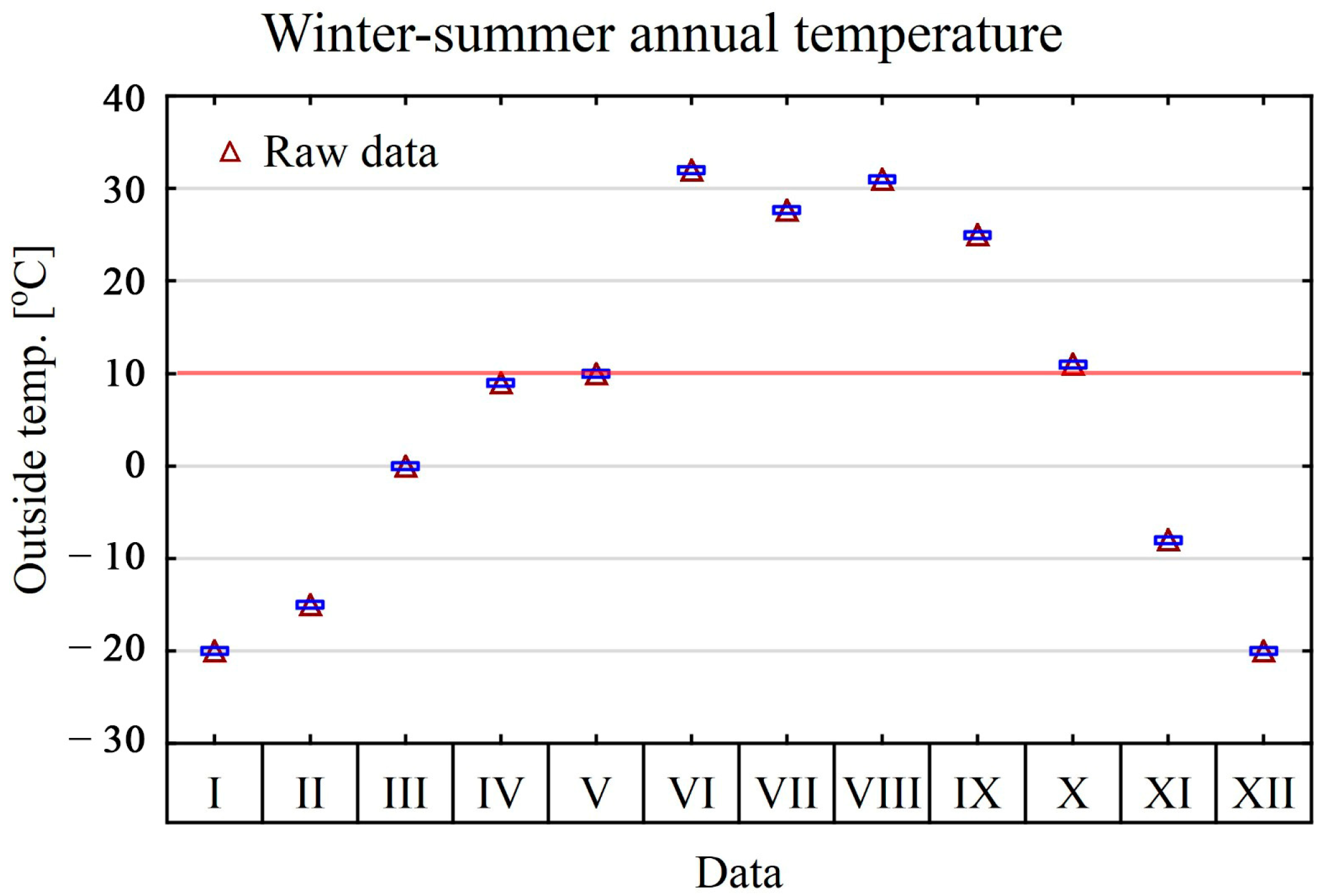
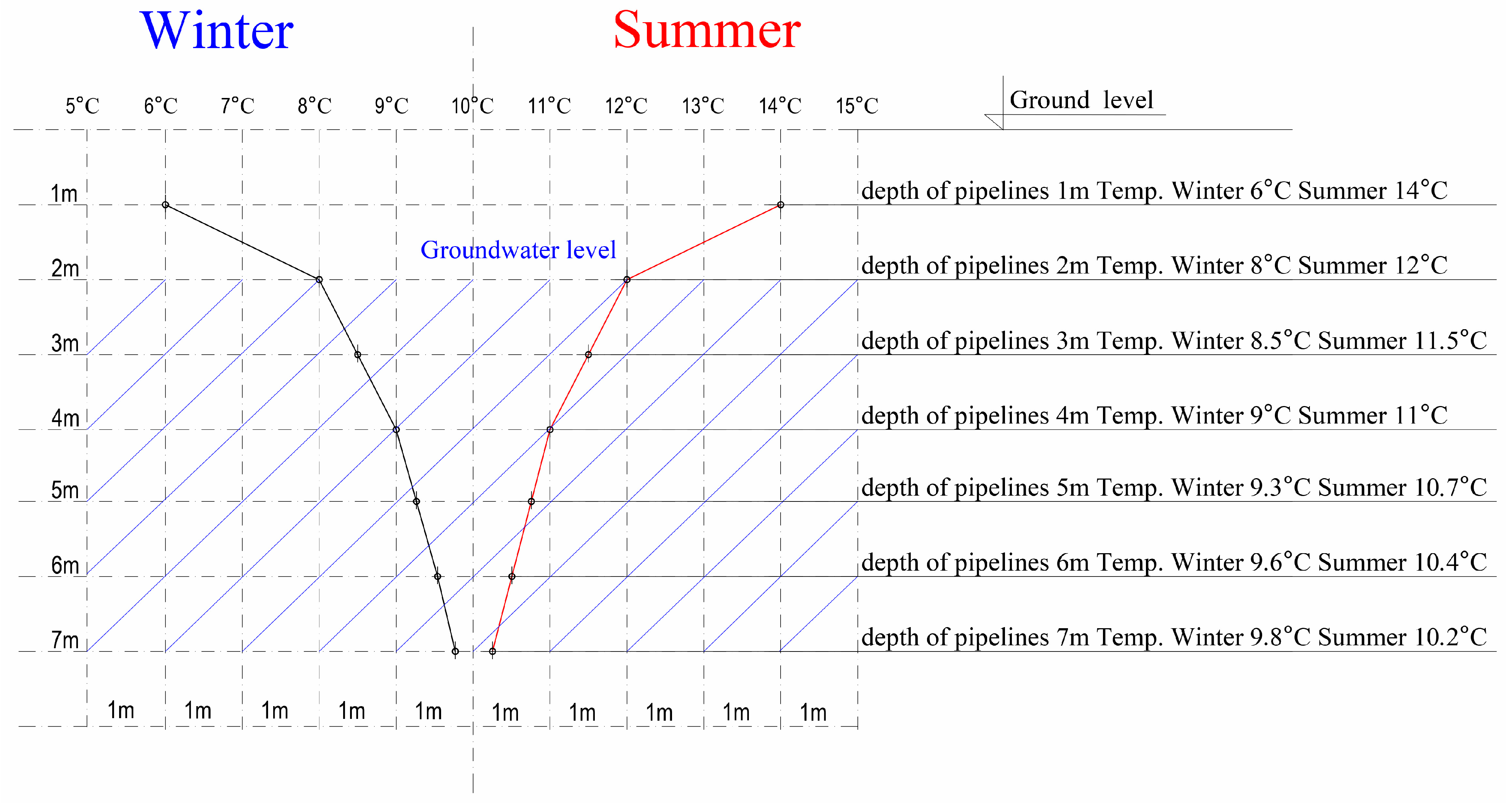

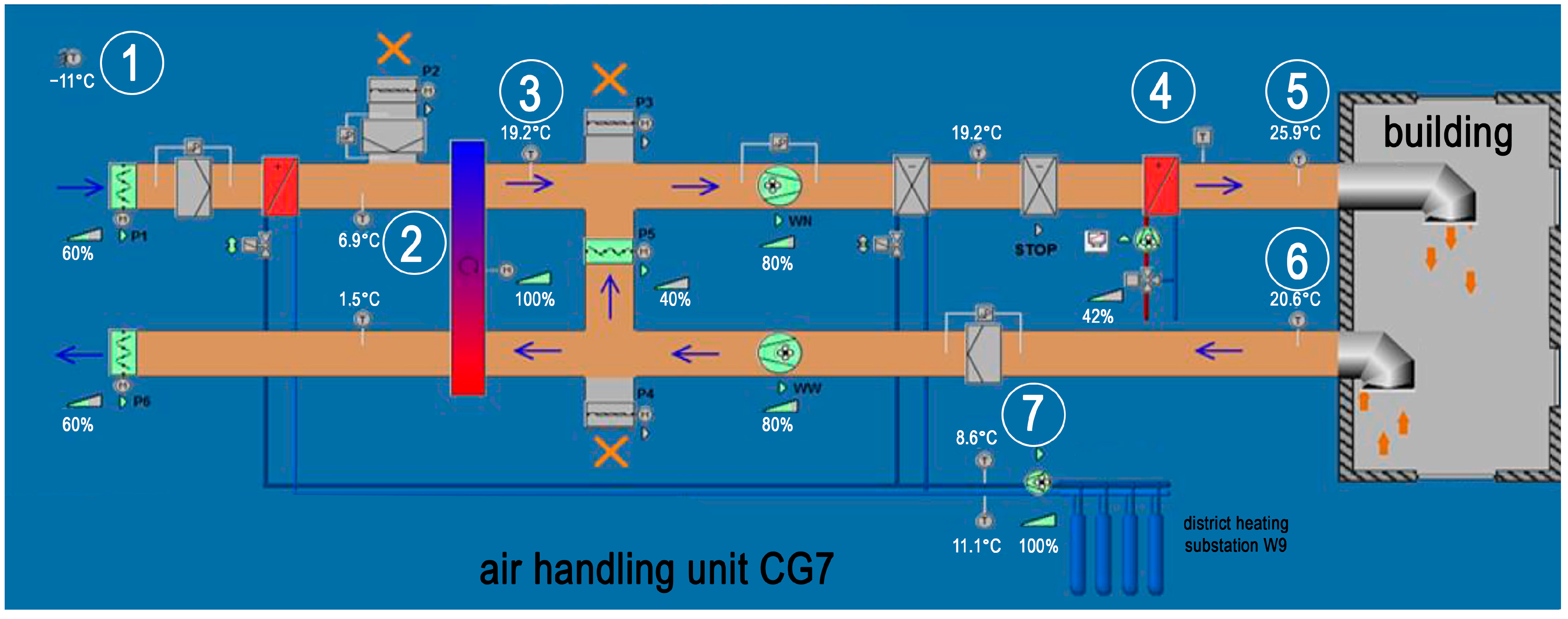

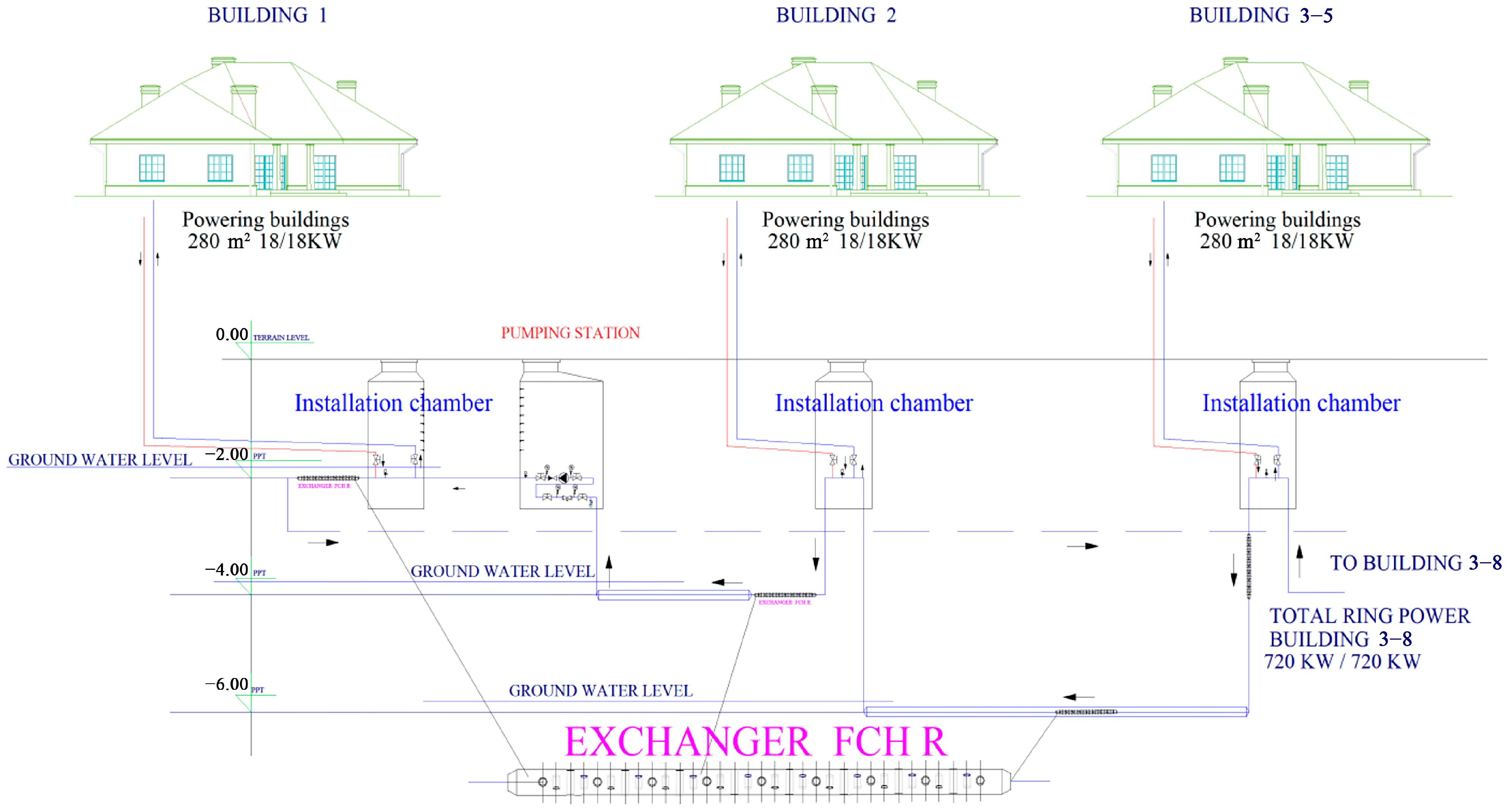
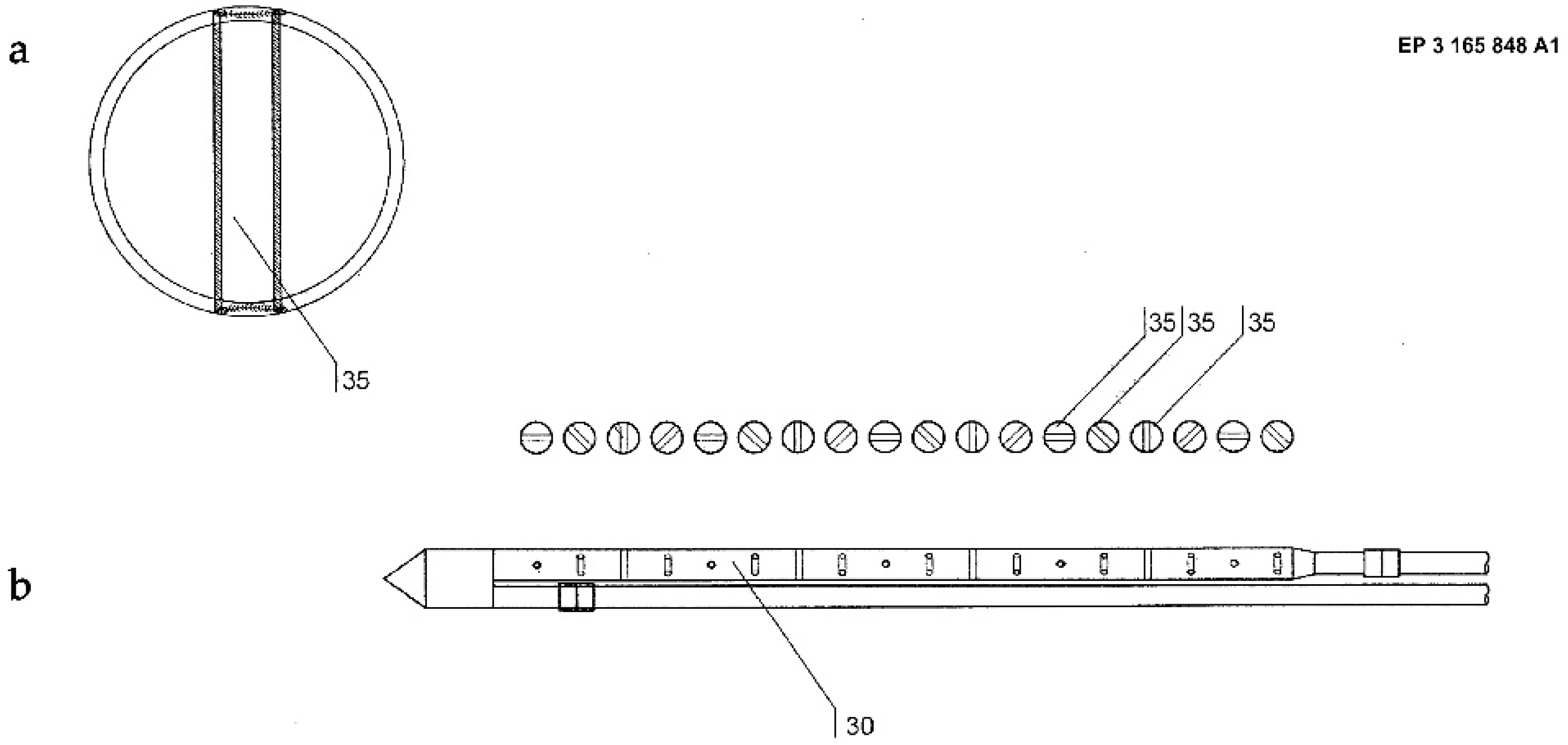
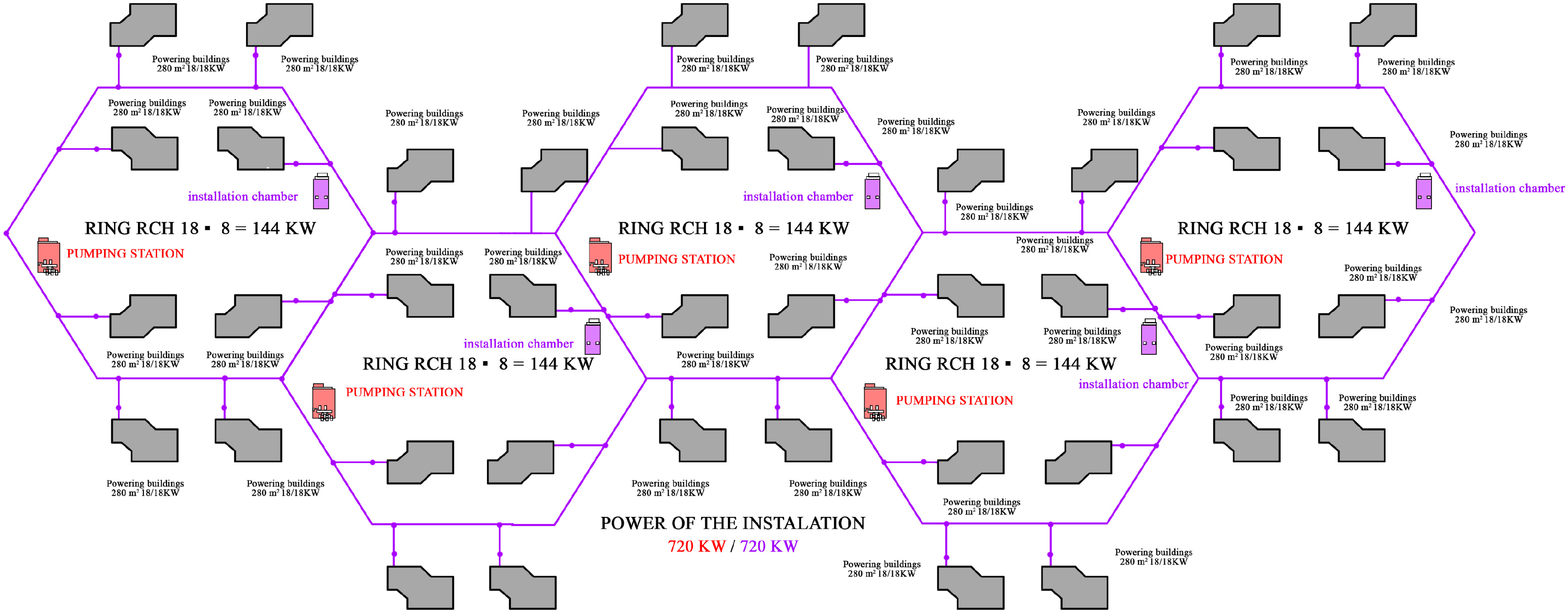

Disclaimer/Publisher’s Note: The statements, opinions and data contained in all publications are solely those of the individual author(s) and contributor(s) and not of MDPI and/or the editor(s). MDPI and/or the editor(s) disclaim responsibility for any injury to people or property resulting from any ideas, methods, instructions or products referred to in the content. |
© 2023 by the authors. Licensee MDPI, Basel, Switzerland. This article is an open access article distributed under the terms and conditions of the Creative Commons Attribution (CC BY) license (https://creativecommons.org/licenses/by/4.0/).
Share and Cite
Wrana, J.; Struzik, W.; Jaromin-Gleń, K.; Gleń, P. FCH HVAC Honeycomb Ring Network—Transition from Traditional Power Supply Systems in Existing and Revitalized Areas. Energies 2023, 16, 7965. https://doi.org/10.3390/en16247965
Wrana J, Struzik W, Jaromin-Gleń K, Gleń P. FCH HVAC Honeycomb Ring Network—Transition from Traditional Power Supply Systems in Existing and Revitalized Areas. Energies. 2023; 16(24):7965. https://doi.org/10.3390/en16247965
Chicago/Turabian StyleWrana, Jan, Wojciech Struzik, Katarzyna Jaromin-Gleń, and Piotr Gleń. 2023. "FCH HVAC Honeycomb Ring Network—Transition from Traditional Power Supply Systems in Existing and Revitalized Areas" Energies 16, no. 24: 7965. https://doi.org/10.3390/en16247965
APA StyleWrana, J., Struzik, W., Jaromin-Gleń, K., & Gleń, P. (2023). FCH HVAC Honeycomb Ring Network—Transition from Traditional Power Supply Systems in Existing and Revitalized Areas. Energies, 16(24), 7965. https://doi.org/10.3390/en16247965






